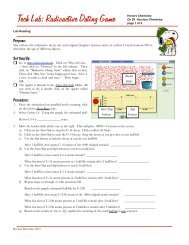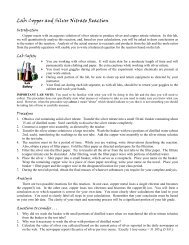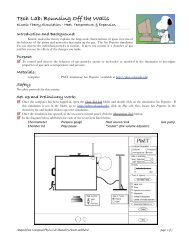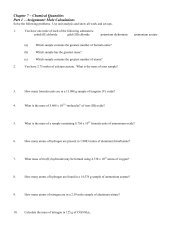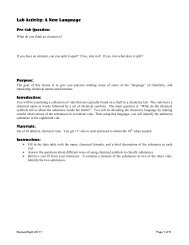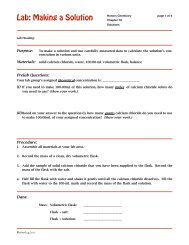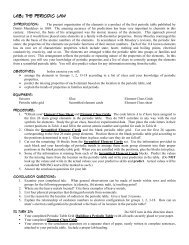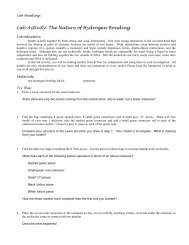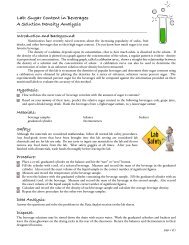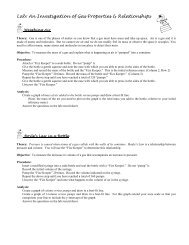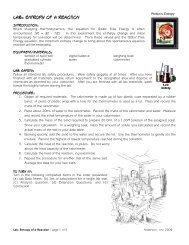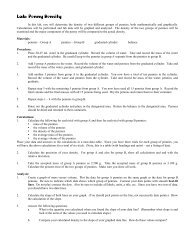Chapter 8 NOTES - Honors Chemistry Coursework
Chapter 8 NOTES - Honors Chemistry Coursework
Chapter 8 NOTES - Honors Chemistry Coursework
- No tags were found...
You also want an ePaper? Increase the reach of your titles
YUMPU automatically turns print PDFs into web optimized ePapers that Google loves.
<strong>Chapter</strong>8 – Chemical ReactionsPart 2 – Notes: Classifying Reactions & Predicting ProductsObjectives: Identify, define, and explain: combination reaction, synthesis reaction, decomposition reaction, single replacementreaction, double replacement reaction, combustion reaction, rapid oxidation, acid-base reaction, dissociationreaction, and ionization reaction.Explain the importance of classifying reactions.Classify a reaction and predict the products for synthesis reaction, decomposition reaction, single replacementreaction, double replacement reaction, combustion reaction, acid-base reaction, dissociation reaction, and ionizationreaction.List three types of products that drive double replacement reactions.Text Reference: Section 8.2 – pages 212-224It is useful to classify chemical reactions because . . .SYTHESIS REACTION: A product is being created (or synthesized) from two or more elements or from two or more compounds.There are always two or more reactants but only one product. Synthesis reactions are also known as composition reactions orcombination reactions. Since a synthesis reaction is one where only a single product is formed, the resulting product must contain allelements/ions present in the reactants without any leftover or additional elements/ions. The reactants and products must be correctlywritten compounds and the equation must be balanced with coefficients to ensure no leftovers.Example:In other words:Let’s practice predicting products for the following:Example 1:sodium + chlorine →Example 2: phosphorus + oxygen → diphosphorus pentoxide (Recall oxygen is diatomic.)DECOMPOSITION REACTION: A single reactant is broken down into two or more elements or simpler compounds. It is thereverse of a synthesis reaction. It has only one reactant but two or more products. Since a decomposition reaction is one where asingle reactant breaks into two or more elements (or simple compounds), the resulting products must contain all elements/ions presentin the reactant with no leftover. The rules are the same for a synthesis – since they are opposite reactants.Example:In other words:Let’s practice predicting products for the following:Example 3: copper (I) chloride → (Recall chlorine is diatomic.)Example 4:water →
SINGLE REPLACEMENT REACTION: An element that is a reactant replaces an element (as an ion) that is in the other reactant.In other words, one partner is switched. Key point: a resulting ionic compound must have a + and a – ion. The switch cannot result intwo positive ions or two negative ions forming a compound. In a single replacement reaction, either the positive or negative ion ofone reactant is replaced by the other reactant (an element that forms either a positive or negative ion). Only positive ions may replaceother positive ions and only negative ions may replace other negative ions.Example:In other words:Let’s practice predicting products for the following:Example 5:aluminum + barium chloride →Example 6:ammonium oxide + iodine →There is one additional point that needs to be considered when predicting products of single replacement reactions: ACTIVITY.In order to correctly predict the products of a single replacement reaction, the chemical activity of the elements that will potentiallyswitch places needs to be considered. In order for an element to replace another, it must be ore active.A more active element will replace a less active element. If this is not the case, then no reaction occurs.Examine the activity series and note any patterns:ACTIVITY SERIESMETALSLithiumPotassiumCalciumSodiumMoreActive↓↓NONMETALSMagnesium ↓ FluorineAluminum ↓Zinc↓Chromium ↓ ChlorineIron↓NickelDecreasingTin Activity BromineLead↓HYDROGEN ↓Copper ↓ IodineMercury↓Silver↓PlatinumGoldLessActiveFor example, for a set of reactants: magnesium and copper sulfate, you need to determine if the magnesium will replace the copperion. You check the activity series. You find that the magnesium is more active than the copper and therefore the magnesium willreplace the copper and the reaction will proceed.
Example 7:Will the following reactions occur? If yes, what are the products? If no, write NR.A. chromium + lead (II) chlorideB. zinc + potassium hydroxideC. magnesium + sulfuric acidD. iodine + sodium chlorideE. fluorine + sodium chlorideDOUBLE REPLCEMENT REACTION: (also known as a double displacement reaction or metathesis reaction) In a doublereplacement reaction, each reactant ion gets a new partner; the positive ions switch thereby giving everyone a new partner. There aretwo reactants, each compound is made of two ions (one positive and one negative). When positive ions switch, each positive ion mustend up with a negative ion (not one to which it had been previously attached). The compounds are written so there is a zero net chargeand then the equation is balanced using proper coefficients to ensure to leftovers.Example:In other words:Let’s practice predicting products for the following:Example 8:sodium chloride + aluminum oxide →Example 9:potassium permanganate + calcium phosphate →There are 3 types of products that drive double replacements reactions. They are:COMBUSTION REACTION: This is a rapid oxidation that usually produced a flame. For our purposes (but not always), oxygen(from the air) is a reactant. Hydrocarbons are compounds that contain hydrogen and carbon. (Combustion reactions may alsoinclude hydrocarbons that contain oxygen in addition to hydrogen and carbon.) When hydrocarbons combust (react with oxygen), theproducts are always carbon dioxide and water vapor.Example:In other words:Let’s practice predicting products for the following:Example 10: C 6 H 6 + O 2 →Example 11: C 2 H 5 OH + O 2 →What’s an acid?What’s a base?Good starting point – A molecular compound that has hydrogen as its “cation.”Good starting point – An ionic compound that has a hydroxide anion.
NEUTRALIZATION REACTION: The reaction of an acid with a base producing a salt and water. (A subset of a DR)In other words:Let’s practice predicting products for the following:Example 12:hydrochloric acid+ sodium hydroxide →Example 13:potassium hydroxide + sulfuric acid →NET IONIC PRECIPITATION REACTION: The reaction producing a solid precipitate (usually) from an aqueous reaction of twosalts. The net ionic precipitation shows only those species that actually react. Any species that remains soluble (dissolved in water)are not included in this reaction. You must include the charge and the state of each species.In other words:Let’s practice predicting products for the following:Example 14:aqueous silver ion + aqueous chloride →Example 15:aqueous lead(II) ion + aqueous hydroxide →DISSOCIATION REACTION: The reaction shows the separation of a soluble ionic salt or a base into its component ions in anaqueous reaction. You must include charge and the symbols to include the state of each species.In other words:Let’s practice predicting products for the following:Example 16:iron(III) chloride dissolves in water →Example 17:barium hydroxide dissolved in water →IONIZATION REACTION: The reaction shows the reaction of an acid in water. The acid and water are the reactants and theproducts include the hydronium ion and the anion of the acid. You should include the charge and the state of each species.In other words:Let’s practice predicting products for the following:Example 18:hydrochloric acid reacts with water →Example 19:sulfuric acid reacts with water →
<strong>Chapter</strong> 8 – Chemical ReactionsPart 3 – Notes: Aqueous ReactionsObjectives: Identify, define, and explain: complete ionic equation, spectator ion, net ionic equation, solubility rules, aqueousreaction, and precipitate.Write and balance complete ionic equations and net ionic equations.Use solubility rules to predict the precipitate formed in a double replacement aqueous reaction.Text Reference: Section 8.3 – pages 225-228Deciding whether a double replacement reaction will occur naturally is actually a matter of predicting whether an insoluble productcan form. Solubility rules are used to determine this. The solubility rules are a listing of the solubility of various substances in water.Some compounds are listed as soluble and other compounds are listed as insoluble. If one of the products formed is insoluble, it is thisinsoluble product that is the precipitate that forms in the reaction. If no insoluble precipitate forms, then there is no aqueous reaction.Negative Ion (Anion)PlusPositive Ion(Cation)CmpdIs. . .Any anion + Alkali metal ions ʺ″ SolubleAny anion + Ammonium ion (NH 4 + ) ʺ″ SolubleNitrate (NO 3 -1 ) + Any cation ʺ″ SolubleAcetate (C 2 H 3 O 2 -1 ) + Any cation except Ag +1 ʺ″ SolubleChloride (Cl -1 )orBromide (Br -1 )orIodide (I -1 )Sulfate (SO 4 -1 )++++Ag +1 , Pb +2 , Hg 2 +2 , or Cu +1Any other cationCa +2 , Sr +2 , Ba +2 , Ra +2 , Ag +1 ,or Pb +2Any other cationʺ″ʺ″Not solubleSolubleNot solubleSoluble+Alkali ions or ammoniumSolubleSulfide (S -2 )+Be +2 , Mg +2 , Ca +2 , Sr +2 , Ba +2 ,or Ra +2ʺ″Soluble+Any other cationNot soluble+Alkali ion or ammoniumSolubleHydroxide (OH -1 )+Ca 2+ , Sr +2 , Ba +2 , or Ra 2ʺ″Slightlysoluble+Any other cationNot solublePhosphate (PO 4 -3 )orCarbonate (CO 3 -2 )orSulfite (SO 3 -2 )++Alkali ions or ammoniumAny other cationʺ″SolubleNot soluble
<strong>Chapter</strong> 8 – Chemical ReactionsPart 4 – Notes and Questions: Endothermic and Exothermic ReactionsObjectives: Identify, define, and explain: endothermic reaction, exothermic reaction, and relative energy changes.Explain the relative energies of reactants versus products of endothermic and exothermic reactions.Classify a reaction as endothermic or exothermic.Qualitatively describe the change to the system and the surroundings in an endothermic or exothermic reaction.Text Reference: Section 11.1 – pages 293-295Reactions may be endothermic or exothermic.1. What is an endothermic reaction?How do you known when a chemical equation represents an endothermic reaction?2. What happens to the reaction system and the surroundings during an endothermic reaction? (Respond in terms of heat.)3. Discuss the relative energies for reactants and products in an endothermic reaction.4. What is an exothermic reaction?How do you know when a chemical equation represents an exothermic reaction?5. What happens to the reaction system and the surroundings during an exothermic reaction? (Respond in terms of heat.)6. Discuss the relative energies for reactants and products in an exothermic reaction.7. Based on energetic considerations only, which is a more probable reaction type: endothermic or exothermic? Why?8. Classify the following as endothermic or exothermic. Then balance the equation.a. ____________________ HI + energy → H 2 + I 2b. ____________________ H 2 O 2 → H 2 O + O 2 + energyc. ____________________ Na + H 2 O → NaOH + H 2 + energyd. ____________________ Cu + O 2 + energy → CuOe. ____________________ NH 3 → N 2 + H 2 + energyf. ____________________ Mg + HCl → MgCl 2 + H 2 + energy



